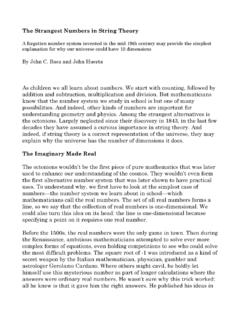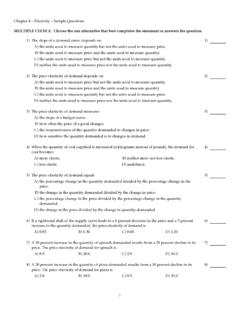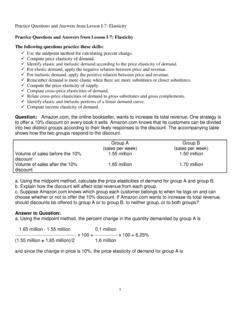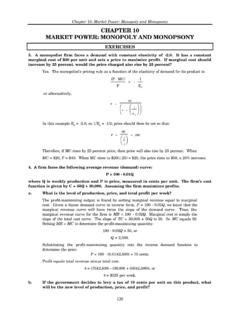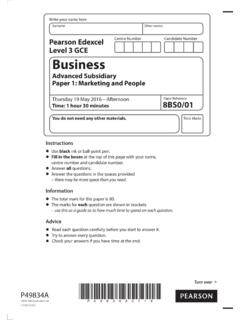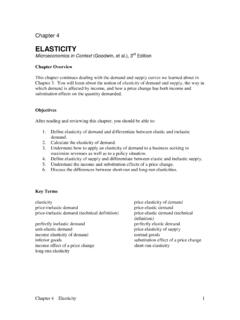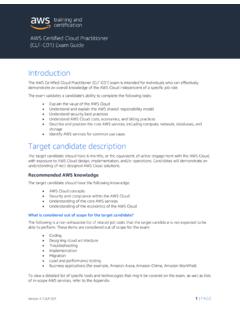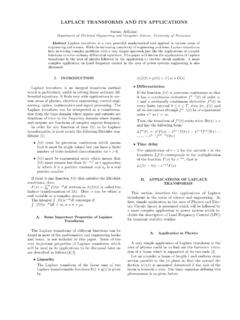Transcription of PriceElasticityof Demand price elasticity of demand elasticity
1 price elasticity of Demand MATH 104. Mark Mac Lean (with assistance from Patrick Chan). 2011W. The price elasticity of Demand (which is often shortened to Demand elasticity ) is defined to be the percentage change in quantity demanded, q, divided by the percentage change in price , p. The formula for the Demand elasticity ( ) is: p dq = . q dp Note that the law of Demand implies that dq/dp < 0, and so will be a negative number. In some contexts, it is common to introduce a minus sign in this formula to make this quantity positive. You should be careful in all circumstances to check which definition is being used. Why do we care about Demand elasticities? One way to see why price elasticity of Demand might be useful is to consider the question: How will revenue change as we change price ? Recall that revenue is price times quantity demanded. If we write ev- erything in terms of price (by using the Demand equation q = q(p)), we get R(p) = p q(p). Now, the derivative of a function tells us how that function will change: If R (p) > 0 then revenue is increasing at that price point, and R (p) < 0 would say that revenue is decreasing at that price point.
2 So, we compute R (p). using the general revenue equation: dq R (p) = q(p) + p dp . p dq = q(p) 1 + . q(p) dp Note that q(p) is always positive, so the sign of R (p) is completely de- termine by the quantity in the brackets. We note that whether this quantity p dq is positive or negative is determined by the size of the second term, , q(p) dp 1. which is precisely the Demand elasticity as we have defined it. Thus, the size, in absolute value, of relative to 1 will determine how the revenue changes as the price changes. (This is why some economists prefer to use the positive version of Demand elasticity .). Now, suppose a manager wants to find out how consumers will react when he increases the price of a good. If increasing the price increases revenue, the manager would have made a good decision. If increasing the price decreases revenue, the manger would have made a bad decision. We use elasticities to see how sensitive are consumers to price changes. Note that the negative sign of the Demand elasticity as we have defined it encodes how Demand responds to price changes: As price increases, quantity demanded decreases, and as price decreases, quantity demanded increases.
3 That is, the fact that is negative tells us price p and quantity demanded q move in opposite directions! Remember, the negative value of comes from the factor dq/dp, which is the slope of the Demand curve which is negative by the law of Demand . (If you had a good that did not follow the law of Demand , then the sign would not necessarily be negative.) Economists use the following terminolgy: 1. When | | > 1, we say the good is price elastic. In this case, % Q >. % P , and so, for a 1 % change in price , there is a greater than 1 %. change in quantity demanded. In this case, management should decrease price to have a higher rev- enue. 2. When | | < 1, we say the good is price inelastic. In this case, % Q <. % P , and so, for a 1 % change in price , there is a less than 1 % change in quantity demanded. In this case, management should increase price to have a higher revenue. 3. When | | = 1, we say the good is price unit elastic. In this case, % Q = % P , and so, for a 1% change in price , there is also an 1% change in quantity demanded.
4 This is the optimal price which means it maximizes revenue. (Why is this so? Draw a graph of revenue versus price for the case of a linear Demand curve to see what is happening.). 2. According to economic theory, the primary determinant of the price elas- ticity of Demand is the availability of substitutes. If many substitute goods are available, then Demand is price elastic. For example, if the price of Pepsi increases, consumers can easily switch to Coke. So the price elasticity of Pepsi is very high. Whereas, if there are few substitutes, then Demand is price inelastic. Even if the price of a basic food items increases, one has to buy this food item to survive. For example, in much of the world, rice is a staple food item, and is an item which is highly price inelastic. There are other types of elasticities besides price elasticity of Demand , but we will not consider them in this course. Example 1. Suppose the Demand curve for oPads is given by q = 500 10p. (a) Compute the price elasticity of this Demand function.
5 Noting that dq/dp = 10, we get p dq = , q(p) dp p = ( 10), 500 10p p = . p 50. (b) What is the price elasticity of Demand when the price is $30? Using our result from (a), we get 30. = = 30 50. Since | | is greater than 1, this good is price elastic, and manage- ment should consider lowering the price to raise revenue. (c) What is the percent change in the Demand if the price is $30 and increases by We note that is defined to be the percentage change in Demand divided by the percentage change in price . This means = 3. Thus, Demand will decrease by (d) How does this change in Demand inform management about its price change? Management should decrease price because the good is elastic. For an increase in price of , quantity demanded dropped by MORE than ( ). Example 2. Benson just opened a business selling calculators. The Demand function for calculators can be given by q = 400 2p2 . Find the price for which he should sell the calculators in order to maximize revenue. Solution We first find an expression for Demand elasticity .
6 Since dq/dp =. 4p, p = ( 4p). 400 2p2. Revenue is maximized at unit elasticity , which is when | | = 1, so we set = 1 and then solve for price p: 4p2. 1 = , 400 2p2. = 400 2p2 = 4p2 , = 6p2 = 400, r 200. = p = $ 3. Thus, Benson should sell the calculators for $ Example3. The Demand for upper bowl tickets to watch the Vancouver Canucks can be given by the function q 2. p = 100 . 10. 4. Find the price elasticity of Demand and determine whether the owner of the Canucks should increase or decrease the ticket price from the current price of $100. Solution There are a number of approaches we could take. First, we note that we have our Demand equation written as p = p(q). We could solve explicitly for q = q(P ) (using the fact that q 0). With this approach, we get . q = 1000 10 p, which gives us dq 5. = . dp p This give us the Demand elasticity 500. = , p(1000 10 p). and so at the price of $100, we have 500 1. = = . (1). 100(1000 10 100) 18. 1. Since | 18 | < 1 , the price elasticity of Demand is inelastic.
7 A small % change in price will cause a smaller % change in quantity demanded. Therefore, the owner should increase the price until the price elasticity of Demand becomes unit elastic in order to maximize revenue. A second approach to this problem would be to use the Demand equation to find the Demand q corresponding to the price of $100. We can then use implicit differentiation to find dq/dp in terms of both p and q, and so do not need to explicitly solve the Demand equation for q. In this case, we first note that q = 900 if p = 100. Differentiating the Demand equation as given with respect to p gives us q 1 dq 1 = 2 100 . 10 10 dp We leave it as an exercise for the student to substitute q = 900 into this expression to find the corresponding dq/dp. You can then compute , which will give you the same value as in our first approach. 5.

